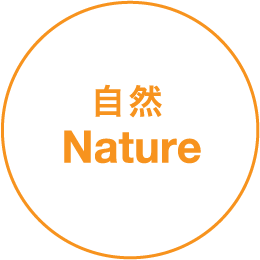
豊かな自然に生きる多様な生物
大三島の魅力は豊かな自然とそこに生きる多様な生物たちだ。
瀬戸内海というと誰もが思い浮かべるのは、大海原に重なり合うように浮かぶ島々、光輝く海の水面、雲が行きかう大きな空、美しい夕景だろう。けれどもその雄大な風景に繊細な味わいをもたらしているのは、人々が長い歳月をかけて築いてきた田畑や家並みだ。自然と人々の営みが共存した里山こそ、日本人の心に深く浸み込んだ原風景なのではないだろうか。本当に瀬戸内の魅力を堪能するのなら、こうした里山をゆっくり散策することをお勧めしたい。
有史以来「神の島」として信仰を集めてきた大三島は、大きく開発されることもなく、豊かな生態系を温存する生物多様性の島でもある。島内には鷲ケ頭山ダイナミック林道、盛―上原みかん山迷路、大三島自然研究路など、サイクリングやハイキングを満喫できる自然路もたくさん整備されている。ゆっくり散策すれば四季ごとに様々な表情を見せる植物や珍しい動物に出会うこともできるのだ。ところがしまなみ海道の開通によって便利になったが、観光客やサイクリストの多くは、島の観光スポットに立ち寄って足早にこの島を通り過ぎてしまう。
この島の自然に詳しい、NPO法人「森から続く道」の副代表であり、環境省自然公園指導員でもある小澤潤さんによれば、この島には塩田、湿地、干潟、砂浜といった多様な地形や大山祇神社の御神山として守られてきた原生林、あるいはコンクリート護岸されていない田んぼなど、豊かな生態系を育む環境が守られているそうだ。そのため身近な里山でも黒メダカ、タニシ、ドジョウに加えて、ダルマカエルなどの希少な生物が生息しているらしい。
こうした貴重な環境を守るための活動も活発で、元婦人会のメンバーを中心に結成された「大三島自然を守る会」の管則子さんによると、地元の自然保護団体と協力しながら、絶滅危惧種であるササユリの群生地調査を通して大三島の自然保護で成果をあげつつある。今後は、希少種の種を撒くなどの活動や環境パトロールに加えて、自然観察会や広報活動を充実させて、島内外の人たちとも連携しながら活動を充実させていく計画だ。
Stunning Nature Is True Luxury
The charms of Omishima Island are truly inexhaustible. First of all,
there is the natural scenery: islands large and small dot the vast
expanse of the sea, the sun sparkles on the water’ s surface,
clouds drift lazily across the enormous sky. The sunsets here are
just incredible.
Counterbalancing the ruggedness of this primordial environment is
the intricacy of the rice paddies, citrus groves, and villages that
people have created over the centuries. The word satoyama
(literally “village-mountains” ) is used to refer to pastoral
landscapes like this one, where nature and human activity are
interwoven, and this is the quintessential landscape of Japan for
which Japanese people feel such fondness and nostalgia. A
leisurely stroll through this rustic environment is all you need to
savor the true charm of Omishima.
Revered since the dawn of written history as the Island of Kami
(deities), Omishima has been spared major industrial development
and retains a rich and diverse biosphere. There is no shortage of
hiking trails where you can enjoy the delights of flora that change
with the seasons, and encounter rare wildlife as well.
According to Ozawa Jun, an expert on Omishima’ s natural
environment, the island’ s biosphere is nurtured and protected by
diverse natural terrain including salt flats, swampland, tidal flats,
sandy beaches, the primeval forest around Oyamazumi Shrine
preserved as the sacred home of deities, and bodies of water such
as rice paddies that are untouched by concrete construction. This
rural environment is home not only to Japanese rice fish, pond
snails, and loaches (freshwater eels) but also to rare creatures
such as the Daruma pond frog. The Omishima Nature Conservation
Society and other local conservationists are working to protect this
precious natural environment, for example by surveying and
monitoring colonies of the endangered bamboo lily.

1 大山祇神社境内にそびえる天然記念物のクスノキは樹齢2、3 千年と伝承されている
2 愛媛県の絶滅危惧Ⅱ類のダルマガエル
3 瀬戸内名物のマダコは伝統的なタコ壺漁で。マダイやマイカなど魚貝も豊か
4 絶滅危惧種のササユリの群生地は大三島の貴重な自然資源だ
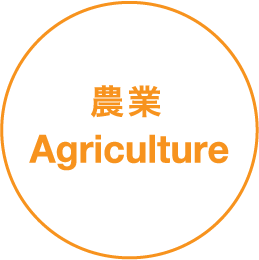
農業がつくるライフスタイル
大三島の美しさは、穏やかな海や大きな空といった瀬戸内海独特の自然だけではない。人の手によって島の斜面に整えられた石積みの果樹畑、狭い
土地に密集している瓦屋根の集落、手入れの行き届いた田んぼや畑など、長い時をかけて人々がつくり、守ってきた里山の風景であり、人々の営みだ。そこには、ひたすら合理性や効率性を求めてきた都市とは相反する、ゆったりした時間と手間ひまを惜しまない身の丈にあった地元思考が息づいている。
その証拠に、この島にやってくるIターン、Uターンの移住者の定着率は他地域に比べて高い。それは都会から新たな暮らしを求めてやってきた人々が夢を実現し、幸せを実感できる風土や文化があることの証でもある。大三島で農業を主体に新しいライフスタイルを実践している人たちをご紹介しよう。
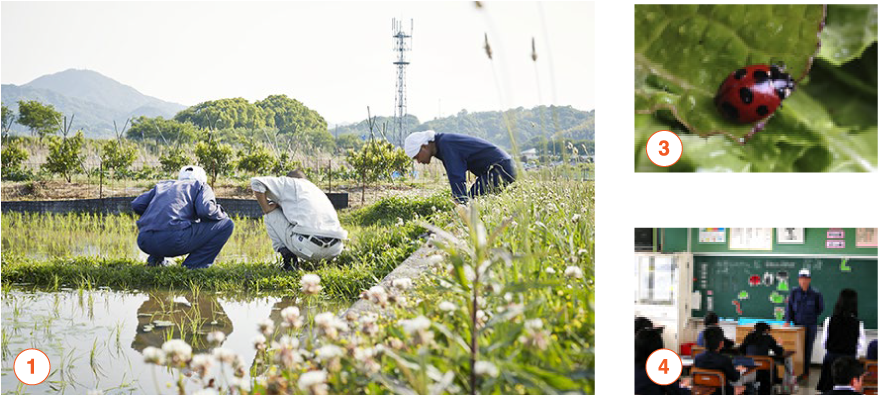
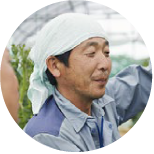
越智資行さん〈べじべじ自然農園経営〉
小規模だからできる自然循環型農業
17年前に一家で関西からIターンしてきた越智さん。今は有機農法に加え、残り野菜を餌にして鶏も飼育、その鶏糞を肥料にしたり、生ゴミはコンポストで堆肥にして畑に返すというゴミを出さない循環型農業も実践している。その甲斐あって、ミミズやてんとう虫も住みつくようになり、耕さなくても保水力、通水力が優れた土壌もできた。作物の種を輸入に頼っている日本の農業に疑問を感じているので、地元在来種の採種にも取り組んでいる。大切なのは、自然と共に生きることの大切さを子どもたちに伝えること。10年前から地元小学校で、循環型農業の授業を行っている。
- 1 田植の後、メダカなどの生物を観察し、その働きを説明
- 2 後進の育成のために、若手への農業指導も熱心に取り組む越智さん
- 3 作物はもちろん、てんとう虫などの昆虫も元気だ
- 4 地元小学校での授業風景
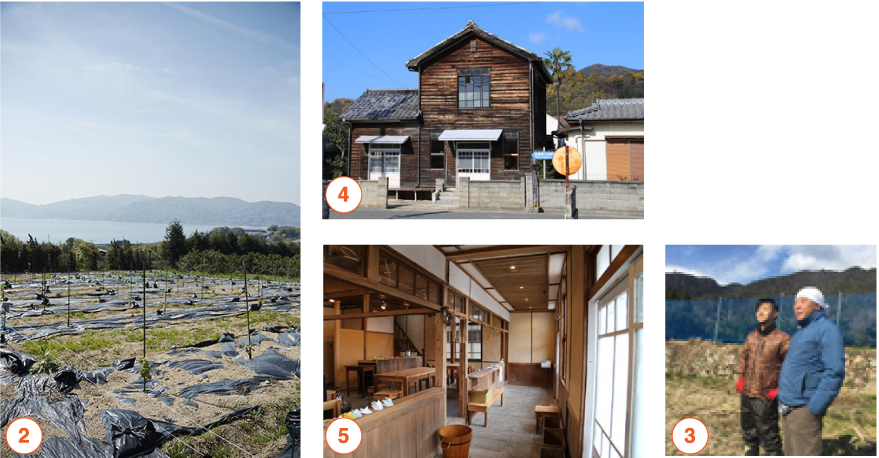
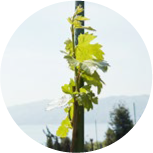
川田佑輔さん〈大三島みんなのワイナリー運営〉
瀬戸内初のワインをつくる
山梨大学でワインに関する専門知識を学んだ。国産ワインといえば山梨だが、地中海に似た瀬戸内海に注目。縁あって林豊さんと伊東豊雄・洋子さん夫妻に出会う。林さんと地元出身の森本百合子さんの協力を得て一反の土地に白ワイン用のシャルドネとヴィオニエ種の苗を植えた。2016年にブドウを収穫してレーズンなど販売、2018年には千本程度出荷したい。昨年度の愛媛県産業振興財団の助成事業に選ばれ、まずはオフィスのある大山祇神社参道の「みんなの家」にワインバーをオープンさせ、瀬戸内初の大三島ワインの足場を固めていきたいと考えている。
- 1 小さな苗は育ち、やがて大三島産のワインの原料になる
- 2 日のあたる島の南斜面に造られたブドウ畑
- 3 林豊さん(手前)と川田さん
- 4,5 ワインバーを開く「みんなの家」は、木の温もりが懐かしい建物だ
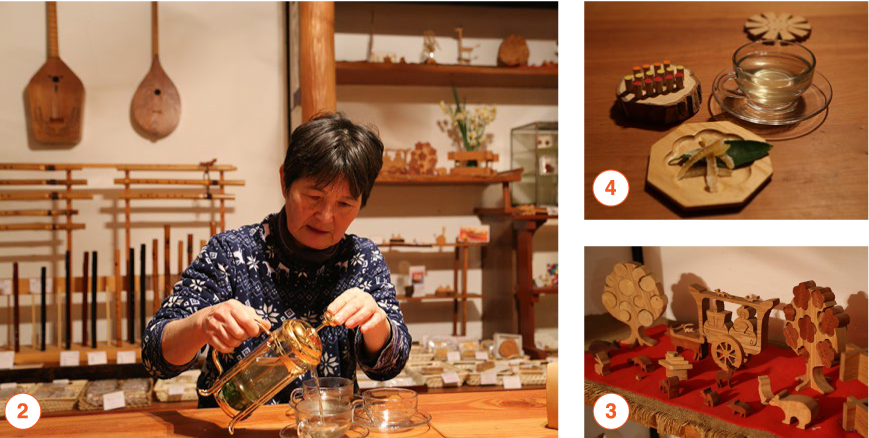
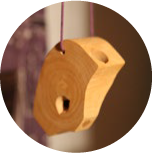
堀内裕子さん〈七曜工房〉
ぺザントな暮らしを求めて移住
2002年、木工好きな夫、弘之さんの長年の夢であった自給自足しながら木工ができる農家生活を実現させるために大三島に移住。まずは職業訓練校で木工の基礎を学び、夫婦で選んだ移住先が大三島だった。古家の横に3年かけて自力で木組みの家を建て、古家は工房とショールームに。今は農業に加えて玩具や雑貨の木のクラフトや笛を製造販売している。特に大三島産のみかんの木や竹を使った笛は評判が高い。一方、裕子さんはハーブを育てて農家喫茶をしている。「七曜工房」には毎日が日曜日、毎日が木工の日という願いを込めている。
- 1 オカリナや笛などの楽器は特に人気がある
- 2,3 所狭しと飾られている弘之さん手づくりの木工製品と裕子さん
- 4 フレッシュな味わいのハーブティと柑橘の皮を使ったお菓子
Agriculture: Creating a Human Biosphere
The beauty of Omishima lies not only in nature but also in human
civilization: stone-walled terraced groves of fruit trees on hillsides,
villages of kawara roof-tiled houses clustered together in small
enclosures, tidy and well-kept fields and rice paddies. The pastoral
landscape that the island’ s inhabitants have created and preserved
over the centuries (photo 1) reflects a value system far removed from
that of the single-mindedly practical and efficient city, and time passes
far more slowly here.
In recent years, there has been a rise in the number of people moving
to Omishima to live, or returning home after living elsewhere, and a high
percentage of them remain on the island over the long term. Clearly
there is something about this environment that fulfills people in a way
urban life cannot. Let’ s see what a few of these transplants or
returnees from elsewhere have to say.
Cyclical Agriculture Only Possible on a Small Scale
Ochi Motoyuki (Vege Vege Natural Farm)
Mr. Ochi, who moved to Omishima from Osaka with family 17 years ago, practices cyclical agriculture. This involves, for example, feeding leftover vegetables to chickens, then turning the chickens’ droppings into fertilizer, which is spread on rice paddies along with compost made from kitchen garbage, making use of all resources and generating minimal waste. The resulting soil is home to earthworms and ladybugs, and is highly heat-retentive and water-conductive (photo 2). Questioning Japanese farmers’ reliance on imported seeds, Mr. Ochi also dedicates time and energy to harvesting native seeds for further planting. For the past 10 years he has also been conducting a cyclical agriculture workshop, which he organized with the goal of conveying to children the importance of coexisting with nature.
The First Wine from the Setouchi Region
Kawata Yusuke (Omishima Minna no Winery)
Mr. Kawata, who has studied viniculture at the University of Yamanashi, took note of the Seto Inland Sea’ s climatic similarity to the Mediterranean. He decided to attempt wine production on Omishima. After eliciting the cooperation of Hayashi Yutaka, a local citrus farmer who relocated to the island, Yuriko Morimoto, and renowned architect Ito Toyo and his wife Yoko, he began growing Chardonnay and Viognier white wine grapes on a tenth of a hectare of land (photo 3). The plan is to sell raisins and juice from the 2016 crop, and then to ship out 1,000 bottles of wine in 2018. With a subsidy from Ehime Prefecture, Mr. Kawata will open a wine bar inside the Home-for-All on the Oyamazumi Shrine approach, and work to popularize wine on Omishima.
In Search of a Self-Sufficient Lifestyle
Horiuchi Yuko (Nanayoukoubou)
Horiuchi Hiroyuki had long dreamed of building a self-sufficient lifestyle through carpentry and agriculture, and he moved to Omishima in 2002 with his wife Yuko in pursuit of this dream. At first they lived in a rented house, which was flooded by torrential rains and high waves during a typhoon, and that spurred Hiroyuki to design their own wood-frame house and build it himself on high ground. In addition to growing citrus fruit, he makes a living by making and selling wooden toys, household items, and furniture. Among his most popular items are musical instruments made with Omishima bamboo, and bird and bug whistles made with mandarin orange tree wood (photo 4). Yuko raises herbs and runs a tearoom serving herbal teas.
Youth Employment Through Lemons
Yamazaki Tomoko (Head of Limone Organic Citrus Farm)
Both of them great lemon lovers, Mr. and Ms. Yamazaki relocated to the island in 2008 from Tokyo with the goal of cultivating lemons themselves. The lemons and other citrus fruits they painstakingly grow with organic and pesticide-free agricultural methods have been granted the JAS organic certification. The Limoncello liqueur, jam, cookies, dressings, and other original foods and beverages they produce in their factory at home with their lemons and other citrus fruits are sold at their Limone store (photo 5) or online, and sales have been increasing thanks to word-of-mouth publicity. The Yamazakis dream of building up their business into one that will employ young people in an exciting and fulfilling work environment.
-
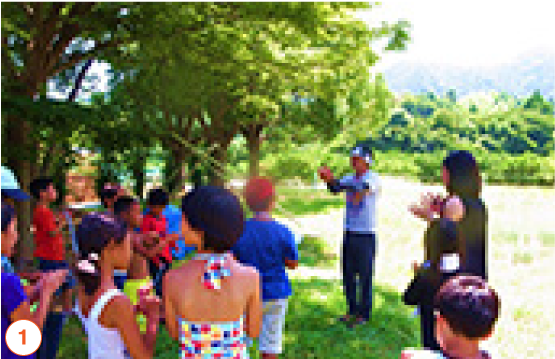

鍋島悠弥さん
〈柑橘農家見習い〉グリーンツーリズムの推進
2012 年に地域おこし協力隊として大三島に移住、2015 年任期満了後は盛地区で柑橘農業を営みながら、民家を改修し農家民宿の開業を目指している。農業や暮らしの体験など「島ならでは」を生かしたいとグリーン・ツーリズムも推進。大切にしていることは人と人との繋がり。盛地区の祭や行事にも積極的に関わっている。
- 1 自らワークショップを企画し、
大三島の自然を満喫してもらう - 2 アイデアマンでもある鍋島さん
- 1 自らワークショップを企画し、
-
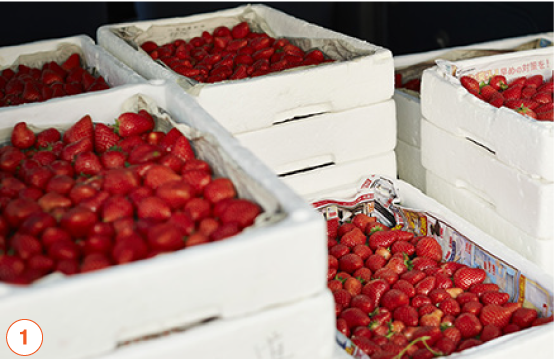
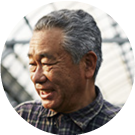
井上正道さん、貞子さん
〈KiKi’ s 苺ハウス〉苺から味覚の豊かさを
知ってほしい自分の子供時代は野にある食材でいろいろな味覚を覚えていた。「苦い」という味覚は、美味しさの大切な隠し味。そんな子ども時代を過ごしていたから、最近の苺が甘さだけを追い求め、酸っぱさなどの味の多様性が失われていることが残念でならない。苺をいろいろ楽しんでもらおうと、シャーベットなどの加工品づくりにも挑戦している。
- 1 温室栽培で収穫されたばかりのフレッシュな苺
- 2 井上さんは、大三島で初めて苺栽培に
取り組んでいる
-
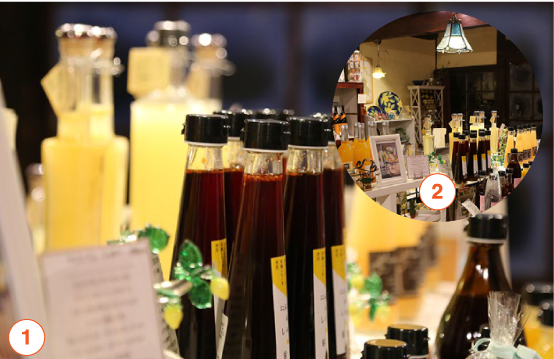
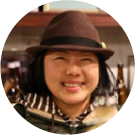
山崎知子さん
〈有機柑橘農家、リモーネ経営〉レモンで島を元気に
とにかくレモンが大好きで、2008年に東京からIターンしてきた山崎さん夫妻。現在無農薬有機農法でレモンなどの柑橘類を栽培。有機JAS認証も取得した。さらに自家工場で製造しているリモンチェッロ、ジャム、クッキー、ドレッシングなどのオリジナルのレモン製品を、直営店「リモーネ」とウェブなどで販売。リキュール製造免許も取得した本格派だ。
- 1 無農薬レモンの加工品だけでなく雑貨も販売
- 2 古い民家をリノべ―ションしたリモーネの店内
- 3 多忙な日々をおくる山崎さん
-
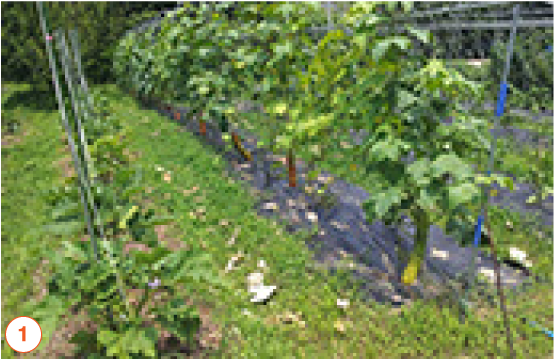

吉川 努さん
〈吉川自然農園〉手間ひまかけて
在来種の野菜を栽培神奈川県からI ターンしてきて有機農業を営んでいる。こだわっていることは種採りできる在来野菜を育てること。野菜には遺伝子操作などを行ったF1 種と、自然のままの在来種がある。昔の農家は自分で種採りするのが当たり前だった。親から子、子から孫へと安心な種をつなぎたい。手間ひまはかかるが安心第一の農業を実践している。
- 1 吉川さんの畑
- 2 在来種の大切さを語る吉川さん
-
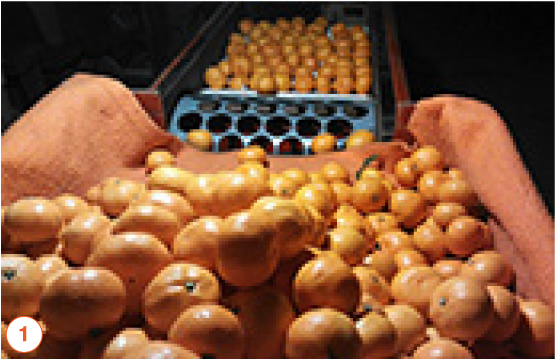
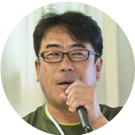
越智敬三さん
〈柑橘農家、恵回会〉仲間と共に
独自の販路を開拓中14 年前に帰島して柑橘農家に。以来、量より質を第一に作物の品質管理を徹底してきた。結果として売り上げを伸ばすことができた。今力を入れているのは、Iターンの人たちと一緒に、独自の販路拡大を目指してつくった「恵回会」の活動を充実させること。段ボール箱をつくって、大三島柑橘のブランドを広めたいと考えている。
- 1 品質管理を徹底して生産された越智さんの柑橘
- 2 恵回会の活動を話す越智さん
-
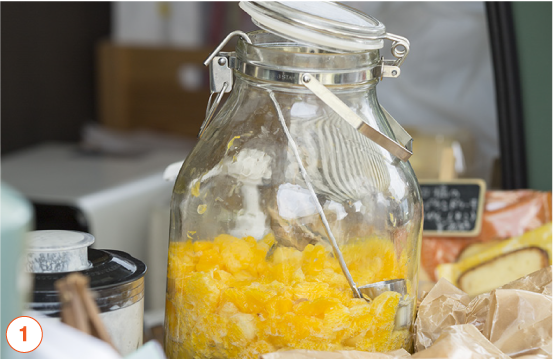

松本佳奈さん
〈しまど、ロコバス運営〉おいしいものを囲んで
集う場所2012 年に地域おこし協力隊として移住。島のおいしいものをもっと知ってもらいたいと、軽自動車を改造した移動カフェ「ロコバス」を経営。人が集まるイベント会場などに駆けつけて、島の柑橘類を使ったオリジナルレシピの飲料や軽食を提供。東京で大三島柑橘の直接販売も企画している。
- 1 大三島産の農産物を使って
自ら準備したメニューはどこでも好評だ - 2 ロコバスでサービスする松本さん
- 1 大三島産の農産物を使って

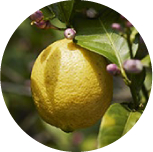
花澤伸浩さん〈花澤家族農園〉
子どもと自然の恵みを実感する日々
- 1 自然農法で元気に実るレモン
- 2 伊予柑畑で有機肥料を撒く花澤さん
- 3,4 収穫した柑橘で手間ひまかけてコンフィチュールをつくる
東京から農業がしたくてIターンで大三島に。今は16カ所、2ヘクタールの土地でカラマンダリを中心に柑橘類を自然農法で栽培している。軌道に乗ってきたのは、土地が肥えてきた8年目くらいから。てんとう虫が住みついて害虫を食べてくれるようになった時期を境に、ようやく満足できる作物が収穫できるようになった。子どもたちと畑に出かけたり、ビニールハウスで野菜を収穫したり、日々、自然の恵みのありがたさを実感している。作物でジュースをつくり、妻がコンフィチュールやクッキーに加工して、できる範囲で通販や産直イベントで販売している。
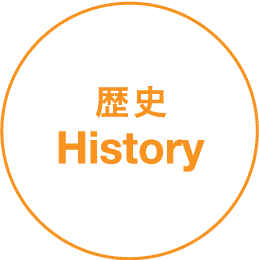
日本の守護神が宿る島
瀬戸内海はその静かな佇まいとは裏腹に、数々の戦いが繰り広げられた歴史的ドラマの舞台でもある。あまたの島の中で大三島が「神の島」と呼ばれる理由は大山祇神社があるから。ここに祀られる大山祇の神様は日本の山々と海を守る偉大な存在でありつつ、戦いの守護神としても崇められてきた。
歴史上名だたる武将が身につけていた鎧兜や刀剣が、この大山祇神社の宝物館で見られるのもそのためだ。国宝8点、国の重要文化財682点を含む歴史的所蔵品の充実度と豪華さは、日本でも有数のもの。源義経や頼朝が身につけた鎧、武蔵坊弁慶の長い薙刀がじかに見られるのが嬉しい。瀬戸のジャンヌ・ダルクと言われる鶴姫の鎧は、紺色のモダンなデザインだ。
推定樹齢2千6百年以上と言われる境内のクスノキも圧巻だ。大山積神の子孫が神社を創建したときに植えたと言われるが、いまも堂々たるこの巨木は生命力をつねに発散しているかのよう。境内裏手の御神木とともに、パワースポットとしても愛されている。
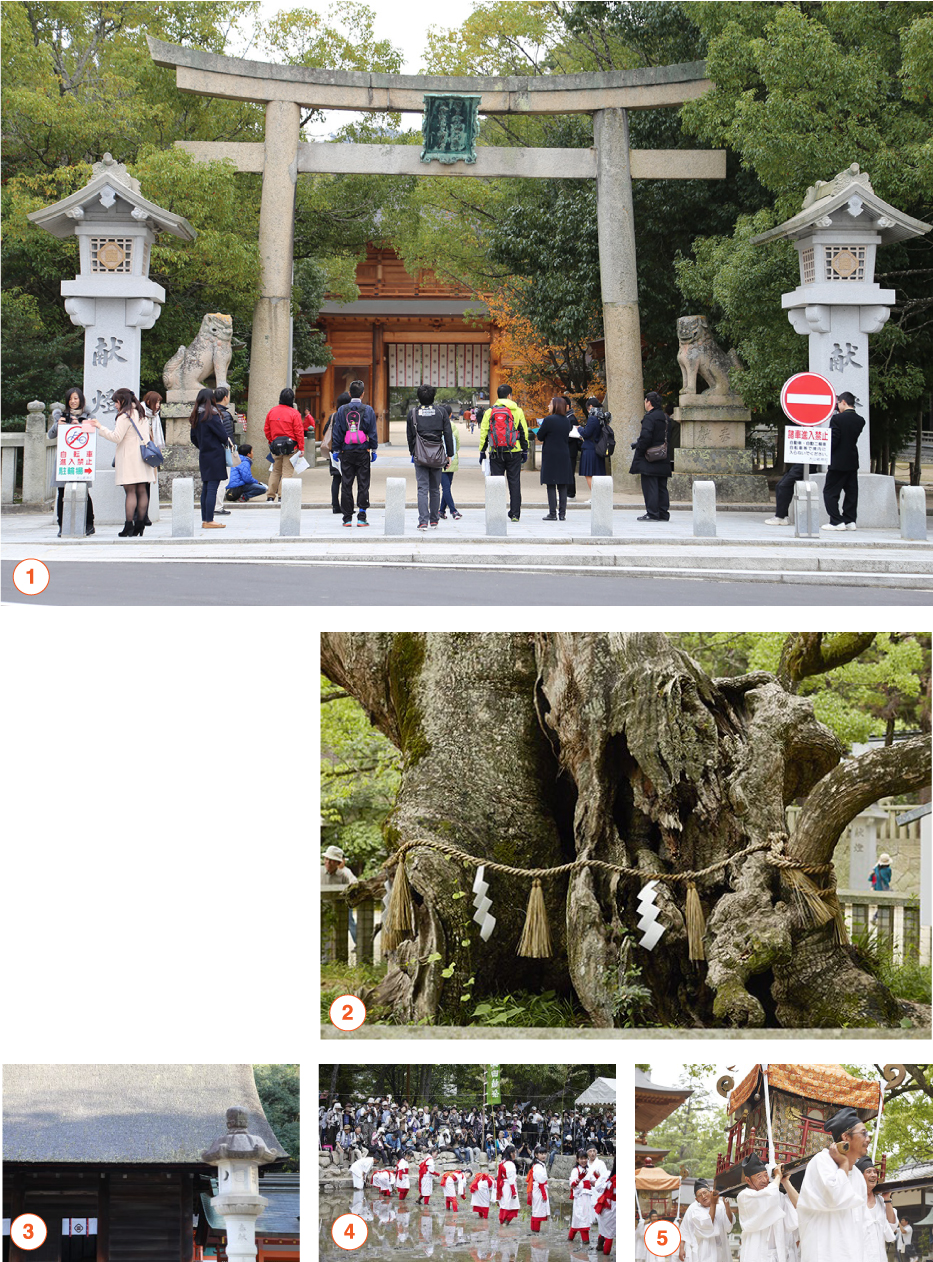
- 1 大山祇神社の二の鳥居で歴史観光ガイドをつとめる大三島の高校生たち。歴代の政
治家や軍人もこの鳥居をくぐった。 - 2 境内で待ち受ける推定樹齢2600年のクスノキは人格さえ感じさせる。
- 3 拝殿の屋根。拝殿は奥の本殿とともに室町時代に再建された、国の重要文化財。
- 4 境内にある田んぼを囲み、少女たちのお田植えの儀式を見守る島の人々。
- 5 大山祇神社での多彩な祭りが、大三島の13の集落を繋いできた。
An Island Protected by Japanʼs Guardian Deities
While it looks placid today, the Seto Inland Sea was the scene of countless battles that raged across the region during the Middle Ages. Since those days, Omishima has been known as the Island of Kami (deities) because it is home to Oyamazumi Shrine. The deities enshrined here are known as almighty protectors, guarding both the mountains and seas of Japan and watching over warriors in battle.
At this shrine with its unique history, the Hall of Treasures exhibits helmets, armor, and swords worn by some of the most legendary military leaders of old. Its unparalleled collection of regalia contains many of the arms and armor designated as National Treasures or Important Cultural Properties of Japan.
The feud between the Genji (Minamoto) and Heike (Taira) clans, one of the most dramatic episodes in Japanese history, is a source of enduring popular fascination, and here you can see the armor worn by some of its main actors, brothers Minamoto no Yoshitsune and Minamoto no Yoritomo. Also on view are the naginata (halberd blade) of the great warrior monk Musashibo Benkei and the helmet of famed female warrior Tsuruhime (known as “Setoʼs Joan of Arc”), which features a striking modern design and navy-blue color.
Also astounding are the sacred camphor trees on the shrine premises, estimated to be at least 2,600 years old. Said to have been planted by descendants of the Oyamazumi deities when the shrine was built, they have grown into majestic colossi that are still burgeoning with life force after millennia.
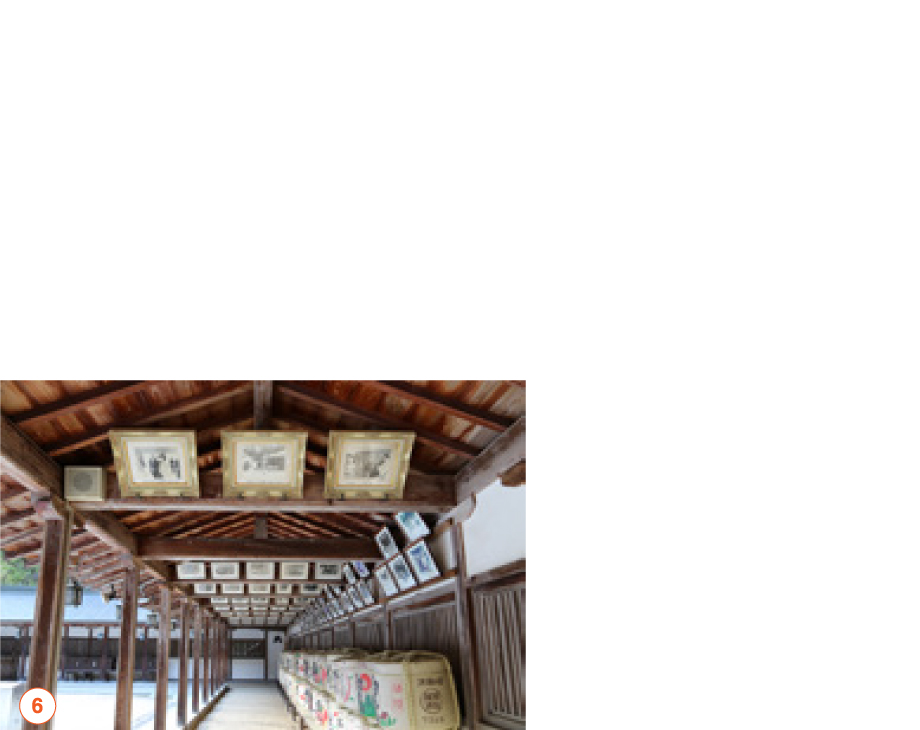
- 6 Both the Hall of Worship and the Main Hall are Important Cultural Properties of Japan, reconstructed in the 15th century.
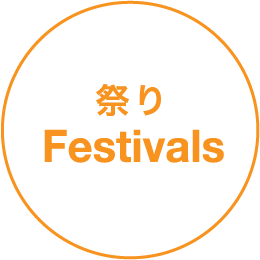
祭が継ぐ文化、祭でつながる人々
大山祇神社が鎮座する大三島には、最高峰の鷲ヶ頭山を取り巻くように13の集落が点在している。自動車が普及する以前、島の交通は船だったので地続きの隣村よりも対岸の島との交流が盛んであった。そのため、集落の独立性が保たれ、神楽、獅子舞、だんじり、弓祈祷など個性豊かな祭文化が育まれた。とはいえ、かつては1万2千人ほどだった島の人口も半減し、祭の開催も難しくなっている。
そんななか、2014年、島はうれしいニュースに沸き立った。島の西南に位置する宗方地区で、200年以上の続いていた勇壮な祭、伝馬船競漕「神事 櫂伝馬」が地元の人たちの努力によって15年ぶりに復活したのだ。今回、祭の復興が実現できたのは、Iターンで宗方に住み始めた林豊さんの呼びかけに、地区のまとめ役、大内正清さん、藤原正富さん、藤原善和さん、市川貞男さんら住民が一致団結して臨んだことが大きい。
祭の復活は思わぬ効果ももたらした。島を離れ、都会などに移り住んでいる人たちを故郷に惹きつけることになったのだ。『ふるさと通信 三っ小島』の発行にもつながった。
開放的な大三島のなかでも宗方は特に明るい住民が多く、林さんのような移住してきた人たちとも良好な関係を築いている。そんな地区だからこそ、15年ぶりに祭を復活できたのかもしれない。昔の日本には結、講、座といった仕組みがあって、村や地域の運営を円滑に行っていた。櫂伝馬の復活は、人々のつながりと文化の復活でもある。
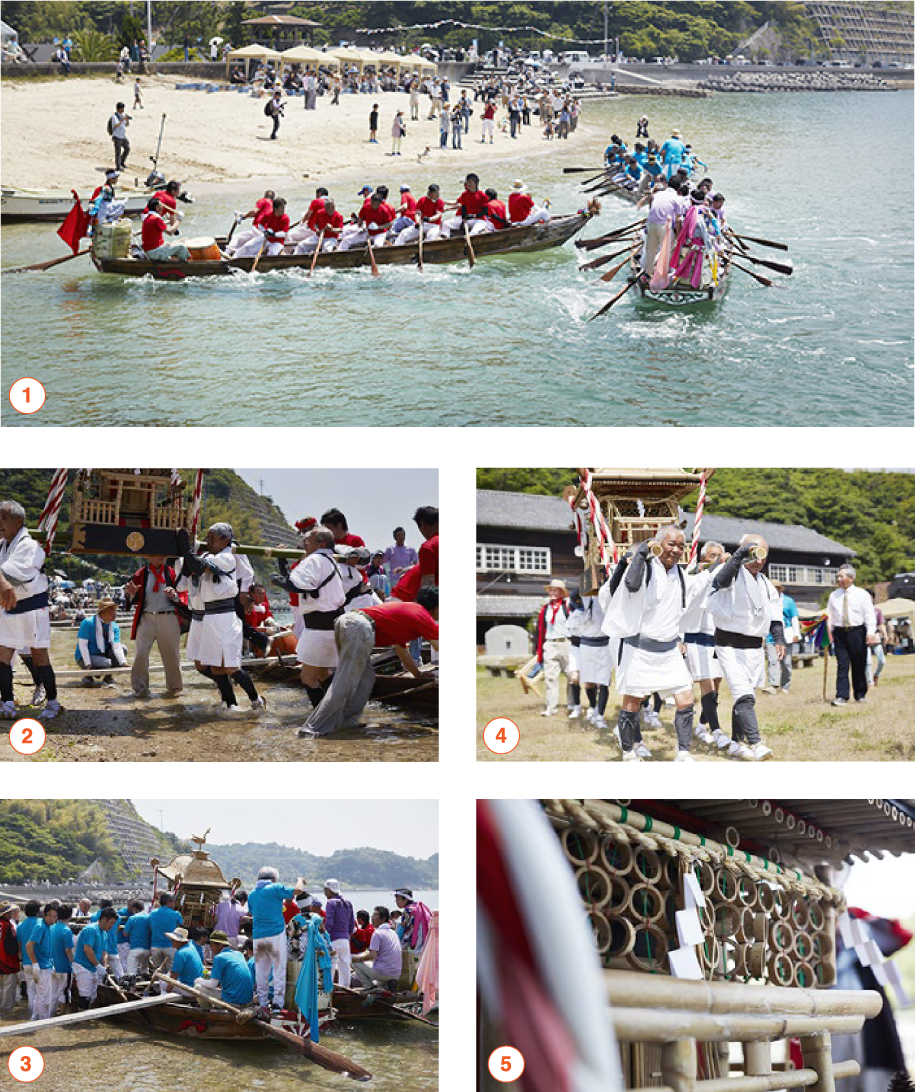
- 1
櫂伝馬は宗方八幡神社に合祀されている厳島神社の十七夜祭として、旧暦6 月17 日
に行われる。地区が三つに分かれ、赤、青、桃色の衣装を着た18 人の男たちが長さ
9.5 メートルの伝馬船を漕いで、速さや雄姿を競い合う。男たちは、太鼓打ち、舵取り、
漕ぎ手と役割がある。船はぶつかり合いなが海を往復する。その由来は水軍発祥説、
海の安全祈願説、宮島管弦祭説など諸説ある
2-5
3 隻の伝馬船による競漕の後、宗方八幡神社から運び出された神輿は伝馬船に乗せら
れ宗方湾を一巡りして、再び神社に帰っていく。
Festivals Unite the People
The island of Omishima is home to 13 villages scattered around the periphery of Mt. Washigato, a sacred mountain in the Shinto faith. Before the advent of the automobile, boats were the primary mode of transport, and people interacted more with villagers on neighboring islands across the water than with those in the next village on their own island. For this reason each village retained its own distinctive character, and evolved unique festivals involving kagura (Shinto sacred music and dance), lion dances, danjiri (festival floats pulled on carts), sacred archery, and more. However, the islandʼs population has fallen from its peak of 12,000 people to around half that, and staging these festivals each year has become a sometimes insurmountable struggle.One festival, Kaidenma, which petered out 15 years ago after continuing for over 200 years, was revived in 2014 thanks to a transplantʼs initiative. A thrilling ritual race between men on long, narrow boats known as tenma-sen, it brought great joy to the island with its resurgence. Local residents young and old came together as one to resurrect this time-honored tradition.
The festival also had the unexpected effect of bringing back former islanders who had moved to big cities. In the past, Japanese villages had social structures involving division of labor among organizations known as yui, ko, and za, which kept the wheels of the village turning smoothly. The revival of Kaidenmaserved to restore these communal bonds and ties to traditional culture.
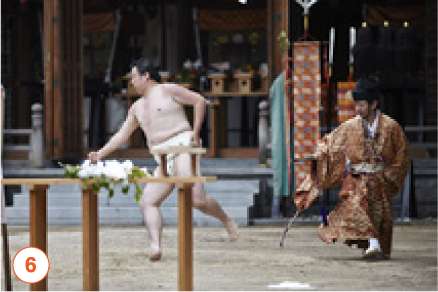
- 6
Sumo wrestling was originally a religious rite, and is still performed at shrines
as a tribute to deities. This takes place at Oyamazumi Shrine, and there are
kids’ bouts as well!
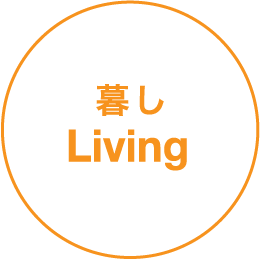
この豊かさをどう活かすか?
しまなみ海道は大三島の東端を縫っている。サイクリストや観光バスが海道でやって来るようになったが、島の反対側に位置する大山祇神社参道を歩く人影はめっきり減った。
かつては島の西側の宮浦港に船で着き、長い参道を歩くのが大山祇詣でのルートだった。参道にはみやげもの屋に食べもの屋、映画館や銭湯も並び、賑わった。
往時と対照的に静まりかえる今日の参道は、空き家や空き地が目立つ。少子高齢化、人口流出、空き家の増加がこの島でも深刻な課題だ。
ところが、大三島の魅力を知って移住してくる人も少なくないのが、この島のグッドニュース。定着率も9割以上と高い。 年からの5年間の移住者数は99人。瀬戸内海の美しく穏やかな風景に加え、災害が比較的少なく、温和な風土が移住したい理由のようだ。
過疎化による社会の下降線と、人間本来の豊かな暮らしへの期待の上昇線が、大三島で静かに交差している現在。この島の可能性をこれからどう広げていくか? 期待を現実に変えるチャレンジが待っている。
林 豊さん〈柑橘・養蜂農家「海sora」経営〉
島に眠る宝は無尽蔵
京都から移住して14年目に入った林豊さんは、農業を営みながら後進移住者の軟着陸を支える活動も行っている。「生きる達人」という表現がフランス語にあるが、林さんはまさにそれ。「採る・食べる・暮らすこのライフスタイルが実現できることが大三島の魅力なんです」と林さん。眠れる食材の発掘や調理法開発にも余念がない。「量や均一性といった市場の論理に従う限り、添加物を使うことになります。でも、大三島で作りたいのは工業製品じゃない。規格から外れるリスクもありつつ、それを超える大三島の魅力を作っていきたいんですよ。」
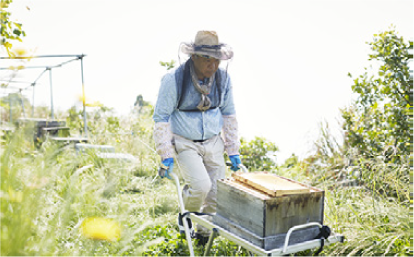
瀬戸内海を一望する
絶景の丘の斜面が林さんの仕事場
小林順子さん〈NPOしまなみアイランド・スピリット〉
空き家活用で島を元気に
高齢化とともに増える空き家や荒廃農地。この負の資源を、移住者が使える資源として開拓するのが「しまなみアイランド・スピリット」の活動だ。障壁は多い。最後の住人が亡くなっても、遺族は何年か供養してからでないと家を貸したくない。だが、数年放置すれば貸せる物件ではなくなる。畑は貸しても農業の技術を教えてくれる人が少ない…。そんなジレンマと戦いつつ、地場の人々と移住者の融合に向けて小林さんは今日も奔走する。
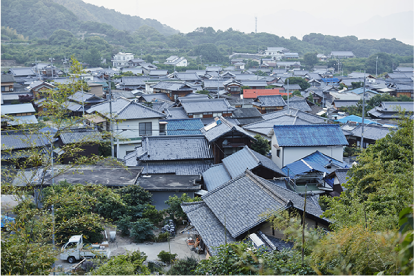
屋根が美しい島の集落。
だが空き家が半数を超える集落もある
衞藤智康さん・史代さん〈オミシマコーヒー焙煎所経営〉
大三島発の焙煎をめざして
みかん畑の向こうに広がる瀬戸内の静かな海を眺めながら、香り立つコーヒーをゆっくりと味わう--大三島にはそんな優雅な時間が持てるカフェがある。コーヒー焙煎を志し、東京から移住した衞藤智康さん夫妻が経営する「オミシマコーヒー焙煎所」だ。自力で改造した味のある民家は1年探してようやく出会った。いまでは島の常連も増え、サイクリストや観光客もやって来る。大三島からコーヒーで発信するのが衞藤夫妻の夢だ。
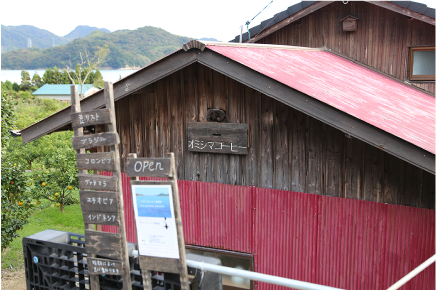
瀬戸内の山と海に囲まれた
カフェ、オミシマコーヒー
藤原史宣さん〈藤原造船所社長・しまなみの駅「御島」社長〉
島民の直接発信を支える
木造船の時代に創業し、海上交通の変動を生き抜いた藤原造船所。今は瀬戸内海圏を走る旅客フェリーを製造している。「道の駅」開設の話が持ち上がった時、大手チェーンの手に渡れば地元の農産物が排除されるとの危機感から、自らの経営を思い立った。「御島」は地元農家や生産者の発信基地であり、サイクリストの補給ステーションとしても重宝されている。
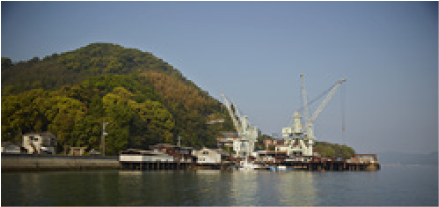
この造船所から時代の変化とともに
様々な船が進水していった
藤原幸子さん〈旅館「茶梅」女将〉
参道に賑わいを戻したい
大山祇神社参道に面した老舗旅館・茶梅。お上の藤原幸子さんは参道の全盛期も、交通手段の変化による島の街と自然の変貌ぶりも知っている。宮浦港から伸びていた美しい松並木はもうない。参道も周辺も空き家が増え、寂しくなった。嬉しいのは参道に賑わいを戻そうとする動きが芽生え始めたことだ。参道マーケット、みんなの家、高校生の歴史ガイドツアー……。藤原さん自身も島の歴史を語り伝えながら、新しい動きを支えている。
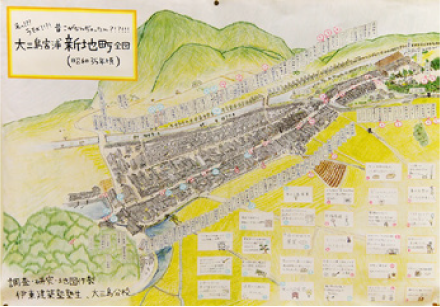
田村先生率いる大三島の高校生たちと
伊東塾が作った、かつての参道鳥瞰図
田村信生さん〈愛媛県立新居浜南高校教諭〉
参道を生きた教育と発信の場に
週末になると地元の高校生たちが参道に現れ、マイク片手に神社や参道を解説して歩く。観光促進と生きた歴史教育を兼ねた画期的な活動を考案したのは、大三島の高校に赴任していた時の田村先生。生徒たちは自ら島の年長者に会って往時の話を聞き出し、観光客たちに伝える。「ガイド本にはない島の魅力を直接伝えることで、リピーター客が増えたらいいなと思って」と田村さん。その成果か、高校卒業後も島に残りたいと思う生徒が増えているという。
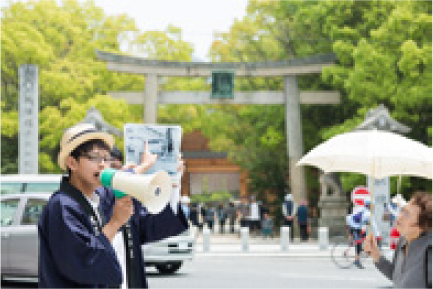
大山祇神社の入り口で
歴史を語る地元の高校生
The Dynamics of Life on Omishima

Since the Shimanami Kaido road opened, a growing number of cyclists and sightseeing buses have been coming to Omishima. On the other hand, the number of people traversing the approach to Oyamazumi Shrine on the islandʼs opposite side has greatly dwindled.
The shrine approach used to be a bustling one, lined with gift and souvenir shops, food shops and restaurants, and even a movie theater and a public bathhouse. Today, empty storefronts and vacant lots are prevalent. Omishima encapsulates all too well the trends of Japan as a whole: a declining birthrate, an aging population, movement from rural areas to urban ones, and a rising number of vacant properties.The good news is that more people are moving to Omishima to live, and more people originally from the island are moving back there, from all over Japan. Ninety-nine people did so over the five-year period starting in 2011. Another hopeful sign is that more than 90% of these people have stayed on the island. Besides the lovely and tranquil scenery of the Seto Inland Sea, the scarcity of natural disasters or extreme weather is another reason people choose Omishima. A stable natural environment is a vital prerequisite for those who seek to make a living through agriculture.
However, the number of vacant houses is increasing at a faster rate than the incoming population. One NPO has started taking on thechallenge of turning these uninhabited buildings into comfortable environments for newcomers to live or carry out various activities. Another organization is working to turn meat from wild boars, which ravage farm fields, into a local island delicacy. If people working to turn negatives into positives in this way join forces, Omishima is sure to flourish ever more in the future.
RIGHT Mr. Hayashi is both a farmer and a hunter. The nearby seaprovides a great variety of fish, shellfish, and seaweed.
TOP A peaceful pastoral landscape: In some villages, 60% of thehouses are unoccupied.
Picking Fruit, Eating, and Living
Hayashi Yutaka
(Mandarin orange farmer, a beekeeper, head of Umi Sora)
Hayashi Yutaka, who relocated to Omishima from Kyoto, says “what I love about this island is the lifestyle‒‒picking fruit, eating it, living off the land.” However, while fully enjoying the lifestyle that Omishima makes possible, he maintains a strict policy as a local farmer. “To deliver the evenly shaped and sized fruit the market demands means using agricultural chemicals. However, what Iʼm doing here is not mass-producing industrial goods. While I run the risk of ending up with fruit that doesnʼt meet so-called specifications, I aim to produce something that more than makes up for that, by imbuing it with the magic of Omishima.”
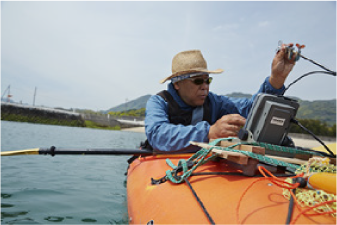
Mr. Hayashi is both a farmer and a hunter. The nearby sea provides a great variety of fish, shellfish, and seaweed.
Enlivening the Island by Refilling Empty Houses
Kobayashi Junko
(NPO Shimanami Island Spirit)
The nonprofit Shimanami Island Spirit faces numerous obstacles to its mission of revitalizing the island through cyclical use of real estate. Even when the last inhabitant of a house has died, surviving family members do not want to rent it out until several years have passed, in line with Buddhist mourning customs. However, after being left untouched for several years, a house becomes unfit as a rental property… NPO member Ms. Kobayashi maintains a positive attitude and stays busy finding constructive common ground between longtime residents and new transplants.
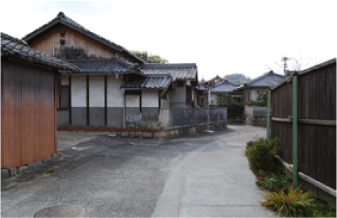
The village street took shape over many years, and it has plenty of potential to accommodate new residents who move to the island.
From Pest Damage Victim to Wildlife Resource User
Watanabe Hidenori
(Leader, Shimanami Wild Boar Resource Utilization Brigade)
Soon after he had started growing mandarin oranges on Omishima, Mr.Watanabe’ s grove suffered damage from wild boars. However, it did not take long for him to go from pest damage victim to wildlife resource user. He immediately teamed up with local hunters and built a slaughterhouse from which boar meat is shipped out to Tokyo and elsewhere. About 800 boars are caught each year on the island, and about 15% of them end up at the Brigade’ s facility now. As the popularity of game meats grows, he aims to ship out more and more wild boar meat, and dreams of making a name for it as a local Omishima specialty.
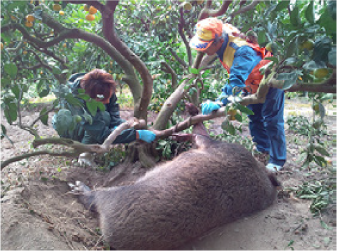
Mr. Watanabe (left) and hunter Mr. Takahashi (right) with a wild boar they felled. It needs to be processed swiftly to and at the slaughterhouse to become a marketable product.
Living History, Education, and Outreach
on the Shrine Approach
Tamura Shin’ u
(Teacher, Niihama Minami High School, Ehime Prefecture)
On weekends, local high school students can be seen on the approach to Oyamazumi Shrine with microphones in hand, providing information about the shrine and its approach. The idea for this innovative extracurricular activity, which also helps to promote tourism, came from former Omishima’ s high school teacher Mr. Tamura. Students meet with the island’ s old-timers in person and listen to stories from long ago, then relate these fascinating tales to visitors. The number of young people choosing to remain on the island after graduating high school is starting to increase, and it seems like these encounters with living history may be part of the reason.
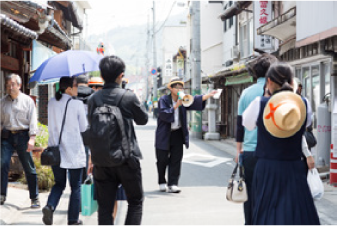
RIGHT A local high school student serving as a tourist guide on the approach to Oyamazumi Shrine.
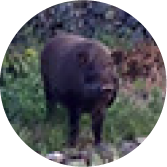
イノシシをリサイクルする
渡邉秀典さん〈しまなみイノシシ活用隊隊長〉
被害者から活用者へ
大三島では年に800 頭のイノシシが捕獲され、うち15% が解体処理場に持ち込まれている。この処理場を作ったのは渡邉秀典さん率いるしまなみイノシシ活用隊で、イノシシの害を島の産業資源に変えるための投資だった。
大三島でみかん栽培を営む家に生まれた渡邉さんは、大学で地域おこしと経営のノウハウを学んだ。だが、卒業して家業を継いだ矢先、猪の被害に遭う。渡邉さんは即座に行動した。猪肉の処理場を建て、捕獲・解体・営業販売のチームプレーを育みながら試行錯誤を重ねたのだ。最初の猪被害からたった5年で、活用事業は軌道に乗り始めた。
活用隊の解体処理ノウハウは評価が高く、いまでは東京のレストランなどからも信頼を得るまでに。ジビエ料理への人気に乗せて猪肉の出荷量を増やし、大三島の産業に育てたいと渡邉さんは考えている。

吉井涼さん〈地域おこし協力隊・猪骨ラーメン開発〉
イノシシに捨てるものなし
豚骨ならぬ猪骨(シシコツ)でダシを取ったラーメンを開発中なのが、埼玉から移住した吉井さんだ。スープは白濁しているが、豚骨と違ってあっさり。エグ味もない。チャーシューも猪肉。あくまで猪の骨と肉から新しい可能性を引き出したいのだ。伯方の塩、大三島産のレモンを使い、地元の素材にこだわったラーメンを目指す。以前は捨てられていた猪の骨が、資源に変わろうとしている。
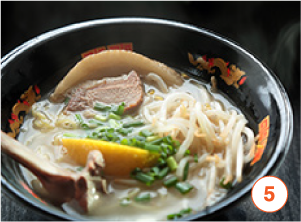
重信幹広さん〈地域おこし協力隊・猪革製品開発〉
豊かな森の副産物
東京と埼玉から移住した重信さん夫妻。イノシシ活用隊のメンバーとして解体にも参加し、猪の革素材と革製品を製作販売している。
野生獣の皮はキズが多いのが悩みだが、なめし技術次第で牛や豚にはないクオリティが出る。猪革は通気性と弾力性に富んでいて丈夫だ。大三島で捕獲される猪は若く、皮の質がきれい。ここ大三島から、猪革の製品価値を変えたいと重信さんは考えている。
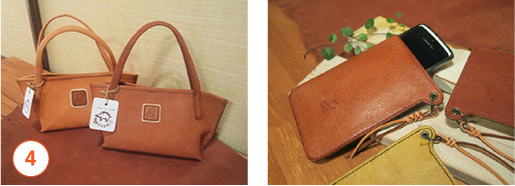
高橋敬一さん〈猟師・高橋モータース経営〉
現場で学んだ捕獲術
しまなみイノシシ活用隊のなかでも、捕獲と解体に抜群の腕をもつ高橋さんの存在は大きい。しまなみ海道ができた頃から大三島でもイノシシの騒ぎが始まったと記憶している。イノシシは頭が良く、海道の橋桁を伝って島に到達したらしい。最初はワナの仕掛け方も分からず、すべて手探りでやってきた。
猪の活用は前進しているが、猟師としての後継者がいないのが高橋さんの悩みだ。
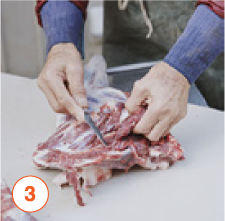
- 1 イノシシのワナを仕掛ける渡邉さん。相手の生態の知識も身につけてきた。
- 2 活用隊メンバーの高橋さん、渡邉さん、藤原教康さん(左から)。他県に比べて上手くいっていると言われる大三島のイノシシ活用の立役者たちだ。
- 3 イノシシ肉はバーベキュー用、ソーセージ、ハム、サラミなどに加工し、大都市に出荷していている。
- 4 重信さん夫婦で手作り生産しているスマホ・ケース(右)とバッグ(左)。デザインは奥さん。
- 5 大三島の猪骨ラーメンは地元の素材が活きる。

